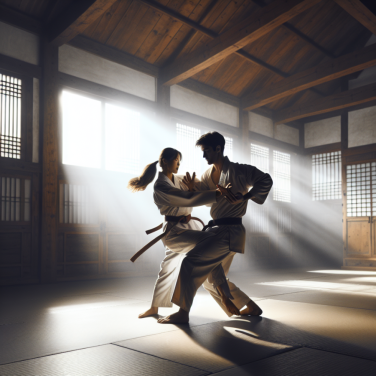Mastering the Dynamic Balance: Hapkido's Fusion of Strength and Suppleness
Hapkido, a Korean martial art renowned for its eclectic and comprehensive approach, is a unique modality that effortlessly exemplifies the blend of hard and soft techniques. Practitioners of Hapkido, or 'hapkidoin', are well-versed in the juxtaposition of force and fluidity, embodying the dynamic balance that characterizes this art form. Learning and mastering Hapkido involves integrating these opposing forces to create a powerful yet adaptable fighting system.
At the core of Hapkido is its philosophy of harmony - the ‘hap’ in Hapkido translates to coordination or blending, 'ki' to the internal energy or spirit, and 'do' to the path or way. This guiding principle is not only philosophical in nature but is also evident in the physical representation of the techniques that encompass both yin (soft) and yang (hard) elements.
The hard aspects of Hapkido are visible when observing the powerful strikes, kicks, punches, and bone-breaking joint locks. These offensive techniques showcase the fierce strength that practitioners develop. Precision, force, and direct application are key facets that define the 'yang' dimension of Hapkido.
On the other hand, the soft techniques are where the art finds its suppleness. Rooted in principles similar to those in Aikido and Jujutsu, Hapkido incorporates throws, grappling, and off-balancing maneuvers that require a practitioner to be fluid and responsive to their opponent’s movements and intent. These techniques draw heavily on circular movements, guiding and redirecting the aggressor's force rather than clashing with it.
One of the unique features of Hapkido training is the emphasis on breathing and energy control, known as 'dan jun breathing'. This practice helps the hapkidoin to not only center their focus and calm the mind but also energize the body for explosive techniques. The controlled expulsion of breath, synchronized with strikes or blocks, can significantly augment the power delivered.
Furthermore, Hapkido’s curriculum includes studying the pressure points and meridians of the body akin to those in traditional Eastern medicine. Knowledge of these vital points allows a practitioner to incapacitate an opponent with strikes that are less forceful yet remarkably effective, showcasing a blend of the art's hard and soft elements.
In practice, a hapkidoin encounters numerous drills and sparring scenarios that foster adaptability. These experiences train them to seamlessly switch between yielding techniques and the use of brute strength as the situation demands.
Read also:
Mastering the Game: Strategies for One-Pocket Billiards
The Art of Peaceful Coexistence: Hapkido's Symbiotic Blend of Force and Elasticity
Hapkido, a Korean martial art, distinguishes itself through a unique philosophy that emphasizes the balance between power and flexibility. This harmony is a defining feature not only in the physical execution of techniques but also in the mental and spiritual approach that practitioners adopt in their training and in their everyday lives.
The art of peaceful coexistence in Hapkido is exemplified by the way practitioners learn to blend force with elasticity. Force, in this context, is not about brute strength or aggressive power. Instead, it refers to the efficient application of energy to control or deflect an opponent's attack. The force in Hapkido is directed and purposeful, with practitioners using an attacker's energy against them. By redirecting the momentum of an opponent, a Hapkido practitioner can neutralize a threat without the need for undue aggression.
Elasticity, on the other hand, embodies the principles of flexibility, adaptability, and resilience. Hapkido students are taught to be like a reed in the wind, bending without breaking. This concept is ingrained in the very techniques of the martial art, where joint locks and throws are performed with a smooth, flowing action that allows a practitioner to move with the energy of an attack rather than rigidly opposing it. The elasticity also refers to the mental flexibility required to remain calm under pressure and to adapt quickly to changing circumstances within a confrontation.
In real-life situations, the symbiotic blend of force and elasticity in Hapkido can be a powerful tool for de-escalation. Practitioners can employ minimal force in combination with their understanding of body mechanics to defend themselves while minimizing harm to the attacker. This approach aligns with the ethical considerations of self-defense; the goal is not to destroy an opponent, but rather to achieve control and restore peace with as little injury as possible to all parties involved.
More importantly, the philosophy of peaceful coexistence teaches Hapkido practitioners to avoid conflicts whenever possible. By understanding the dynamics of power and flexibility, students learn the value of resolving confrontations in a non-violent manner. This perspective cultivates a mindset of respect for others and an awareness of the impact of one's actions, which extends far beyond the dojo into personal and professional relationships.
Training in Hapkido, therefore, is not merely about physical preparation for combat. It is also an education in the art of living harmoniously with others.




